Flooring

The purpose of floor is to provide horizontal clean surface to support the occupants of a building, furniture and equipments. The floor structure must be strong enough to bear super imposed loads. The strength of floor depends on type of flooring you use.
Types of Flooring
The following are commonly used types of flooring.- Cement Concrete flooring
- Terrazzo flooring
- Crazy Marble flooring
- Brick flooring
- Ceramic Tile flooring
- Marble flooring
- White Marble Flooring
- Kota Stone flooring
- Wooden flooring
In addition to the flooring mentioned above there are some special types of flooring.
- Linoleum
- Rubber Flooring
- False Flooring
- PVC Flooring or Vinyl flooring
Cement Concrete Flooring
Cement and concrete are main components of both commercial and residential flooring. Cement is key ingredient in concrete products. It is binding agent that holds sand and other aggregate together in a hard, stone-like mass.Concrete is produced by mixing cement with fine aggregate (sand), coarse aggregate (gravel or crushed stone), water, and often small amounts of various chemicals called admixtures which control such properties as setting time and plasticity. When the water is added to cement, it forms a slurry (thin semi-liquid cement) or gel that coats surfaces of the aggregate and fills the voids to form solid concrete.
The ratio of water and cement is the key that determines the strength of concrete whereas aggregates provide thickness, and decoration in some cases. Cement concrete flooring consists of cement concrete in the ratio of 1:2:4 (1 part of cement, 2 parts of coarse sand, and 4 parts of graded stone aggregate). Its thickness varies from 25mm to 50mm. The base concrete should be provided with slopes.
Flooring in veranda, courtyard, kitchens, and baths should have slope ranging from 1:48 to 1:60 depending on the location. Floors in water closet should have slope of 1:30.
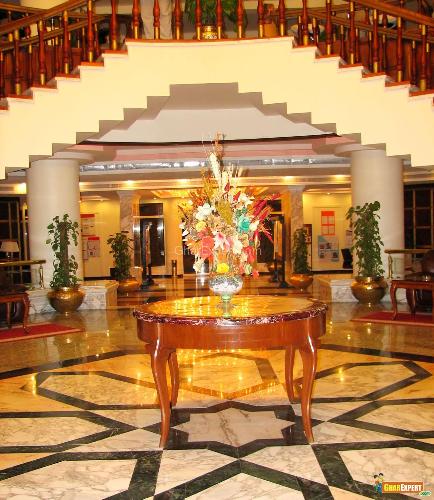
Concrete Cement flooring... back in trend
Terrazzo Flooring
It is popular flooring for residential as well as public buildings. Terrazzo tiles have a smooth shine and are designed with marble or granite chips which add attractive designs to them. It’s available in an excellent range of colors and textures. This flooring is usually not slippery when wet because this has many grout lines.Terrazzo flooring consists of an under layer of cement concrete in ratio of 1:2:4 (1 part of cement, 2 parts of coarse sand, 4 parts of graded stone aggregate, 12.5 nominal size). Its thickness varies from 34mm to 28mm. Thickness of top layer of marble chips varies from 6mm to 12mm whereas the thickness of terrazzo flooring depends on the size of marble chips used.
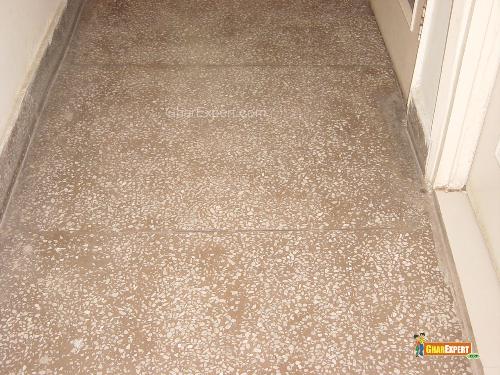
Terrazzo floor
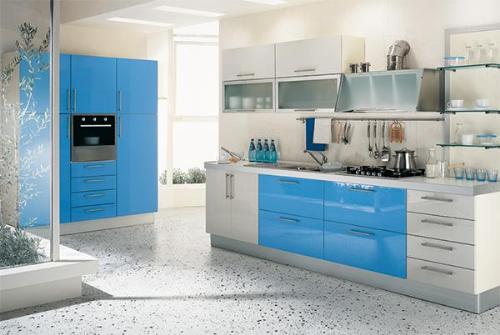
A blue white blend of color in kitchen with perfect terrazo floor
(This Picture is Contributed by "Apurva Sharma")
Crazy Marble Flooring
It is little different from mosaic flooring for its casting. The cement concrete under layer of crazy marble should be 25mm thick. Marble stone pieces are laid on cement concrete base. The usual thickness of marble stone pieces is 20 mm to 30 mm. The mix of cement chips 4:7 is laid around stone pieces.The mix of crazy marble stone flooring consists of white cement-marble powder mixture (ratio 3:1) by weight in proportion of 4:7(4 cement-marble powder mixes: 7 marble chips).
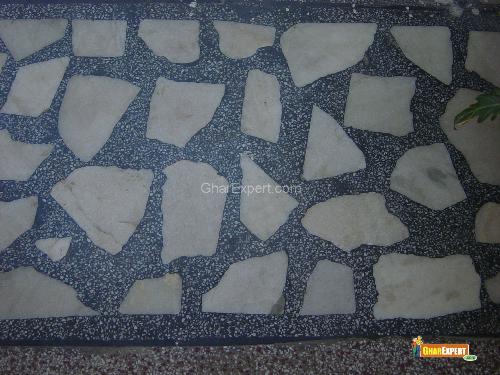
Crazy Marble Flooring
Brick Flooring
Bricks are very easy to install. As bricks are slip resistant you can avoid danger of slippery even when the floor is wet. This is the cheapest floor and is used in low category houses and temporary structures.Cement mortar in ratio 1:4 or 1:6 (1 part of cement, 4 or 6 parts of coarse sand by volume) is used in brick flooring. Brick flooring laid on base concrete consists of 75 mm thick lime concrete mix or cement concrete mix (ratio1:4:8 or 1:5:10).
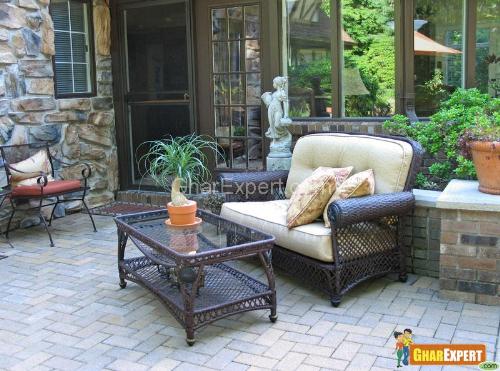
Brick Floor on Terrace

Trendy Brick Floor
(This Picture is Contributed by "Sharmishtha")
Ceramic Tile Flooring
One of the most common uses of ceramic tiles is for flooring design in homes. Ceramic tiles are affordable, have low-maintenance, and can easily match with any room decor. These tiles come in various sizes, shapes, thicknesses, and colors, and are either glazed or unglazed.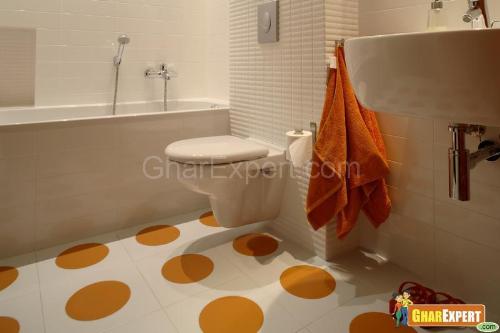
Ceramic Tile Flooring with minimal designing
Tiles are available in different sizes.
| Length (mm) | Breadth (mm) | Thickness (mm) |
| 200 | 200 | 5-6 |
| 250 | 250 | 5-6 |
| 300 | 300 | 5-6 |
The thickness of ceramic tiles for floor is 8 mm.
Marble Flooring
Marble is usually found as rectangular, square tiles or as whole slabs. One side is smooth and the edges are beveled (sloping). Marble tiles provide beauty for years and functionality to your home with low maintenance. These tiles are durable and available in varieties of colors such as white, pink, green, grey etc. these tiles come in plain as well as textured form. This flooring provides an elegant, royal and decorative look to the room. They are suitable for almost any place.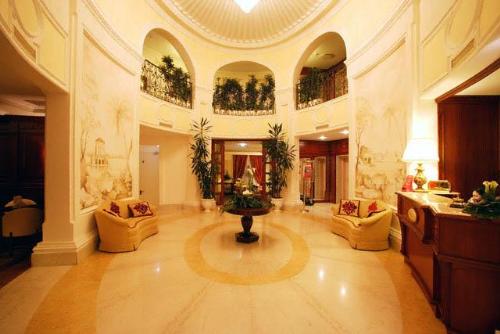
Royal villa with marble flooring
(This Picture is Contributed by "Ahmed")
White Marble Flooring
White marble stones of good quality are used. These stones have uniform veins and are spotless. This flooring is recommended for Hotels, Hospitals, Rest houses and Ban glows.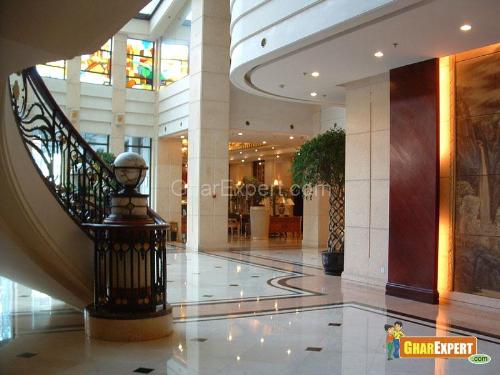
White Marble Flooring with minimal designing
Kota Stone Flooring
Kota stone is a flat rectangular limestone. It is available as rough natural slab in natural blue, green and brown color. Kota stone is a natural stone which provides value for money to common man. It is hard and strong and remains undamaged for hundreds of years, yet it is cheap in prices. Kota in its natural surface is useful for exteriors and high traffic areas like swimming pool etc. It offers non slippery surface and good look. Its polished surface finish is highly suitable for Interiors. It can be used in bedroom, dining room, guest room, particularly in circulation area. in fact in whole house, office etc.Wooden flooring
Hardwood flooring is one of the most popular and beautiful flooring which has been in use for years. It has an elegance, charm, and durability that make it a popular choice in most of modern homes. The style of hardwood flooring you choose should be a decision based on your lifestyle, the construction of your house, and your budget.This flooring may be used for auditoriums, dance halls, gymnasium floors etc. The thickness of wooden blocks does not exceed 10 mm. The blocks are laid in desired patterns and they are fixed by means of hot glue. Then they are nailed with the help of panel pins. The heads of these pins are punched off and putty is filled in the holes.
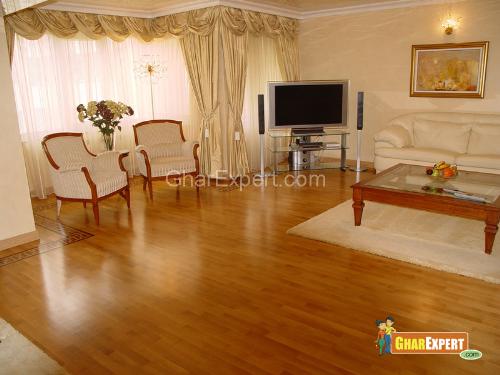
Wooden Flooring

Wooden dine
( This Picture is Contributed by "Sharmishtha")
Special Types of Flooring
Linoleum Flooring
This flooring is a mixture of linseed oil, gums, resins, pigments, wooden flour, cork dust and other filling materials. It is available in rolls of width about 1.80 meters or 3.60 meters. The thickness varies from 2mm to 6mm. Linoleum flooring is also available in form of tiles. Linoleum flooring should be laid over an effective damp-proof area.
This flooring is attractive, cheap, durable, comfortable and moderately warm and it can easily be cleaned. It reduces noise to a considerable extent and is used for residential buildings, restaurants, railway carriage, pubic transport buses, hospitals, schools, libraries, offices etc.
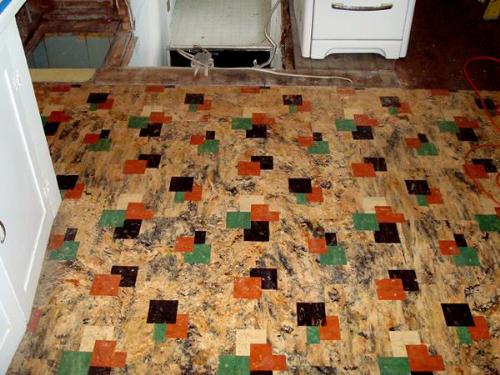
Multicolored Linoleum flooring
(This Picture is Contributed by "Tara Vajpayee")
Rubber Flooring
This flooring is a popular choice today. It is available in form of tiles and sheets which are made from synthetic rubber. It comes in plain, ribbed, fluted or other raised patterns. It is suitable for locations where a non-conducting floor (where heat or electricity can not pass through) is required. For e.g., laboratories, amusement parks, etc. This flooring is a mixture of raw rubber, fillers such as fiber, corks, etc. and pigments. A small percentage of ‘sulphur’ is added to speed up the process of vulcanization (The process of making soft rubber harder by reaction with ‘sulphur’ naturally). The material is available in different colors for both sheet and tile forms.
Rubber flooring can be laid over any smooth and dry surface. This flooring is elastic, attractive, noiseless, sanitary, comparatively warm and soft but it is affected by oil and grease. This flooring is used for bathrooms, hospitals, X-ray rooms etc.
False Flooring
False Flooring is normally used in computer rooms for routing cables under floor. The floor panel should be made of 35mm thick ‘Nova teak Super’ particle board, 2mm thick PVC tiles on top surface and the underside should be coated with fire resistant paint. The edges of floor panel might expose PVC edging. The entire floor should be capable to take distributed load of 1200 kg. per sq/m. and a safe point load of 400 kg uniformly at the center of panel with a maximum deflection of 2mm.
PVC Flooring or Vinyl flooring
This flooring is waterproof and is easy to clean. It is hard wearing and bears high wear resistance and hardiness. It is unbreakable and flexible. You can easily replace any damaged section of the flooring if you use vinyl-flooring tiles instead of sheet. This flooring also comes in a large variety of finishes these days including slip resistant vinyl flooring which is ideal for areas the public often walks on. This flooring is bacteria-free and resistant to chemical as the surface of Vinyl flooring offers resistance to attack from soft and diluted acids, alkali, petrol, soaps and detergents. However, any chemical spilled on the surface should be cleaned immediately to minimize any possible damage.
The sizes available normally are; width 1.5 meter in rolls and continuous length up to 20 meter. The thickness 2 mm and 1.5 mm has many selected shades.
There are three main steps which occur during layout of floors.
First step: Leveling of the filled up earth including watering, ramming.
Second step: Laying fine sand and cement concrete for base coat.
Third step: Lying floor toping may be of any type of flooring i.e. Brick on edge flooring, conglomerate flooring, terrazzo flooring, marble flooring, ceramic tile flooring etc.
 Epoxy flooring can be defined as several layers of any type of epoxy resin that is applied on a floor surface. This type of flooring may be used on both on the flooring of homes and Industries. Epoxy flooring has many advantages as it is slip resistance, durable, clean and easy to maintain and it comes in several colors as clean white, slate and silver grey and can also have a specific color.
Epoxy flooring can be defined as several layers of any type of epoxy resin that is applied on a floor surface. This type of flooring may be used on both on the flooring of homes and Industries. Epoxy flooring has many advantages as it is slip resistance, durable, clean and easy to maintain and it comes in several colors as clean white, slate and silver grey and can also have a specific color.
 Cork is a new option for flooring these days. Cork is made from oak tree and gives a natural feeling for flooring in home or for your work area. Find out more about cork flooring right here.
Cork is a new option for flooring these days. Cork is made from oak tree and gives a natural feeling for flooring in home or for your work area. Find out more about cork flooring right here.
 Bamboo flooring is noiseless and adds prettiness to interior of your home. It is tough, durable and environment-friendly. Here is what we should know about bamboo flooring.
Bamboo flooring is noiseless and adds prettiness to interior of your home. It is tough, durable and environment-friendly. Here is what we should know about bamboo flooring.
 Terrazzo flooring is popular for residential as well as public buildings since it is not slippery when wet.
Terrazzo flooring is popular for residential as well as public buildings since it is not slippery when wet.
 Hardwood flooring is one of the expensive yet elegent flooring option. Its installation is not that typical but still needs a lot of care as a flooring not done carefully could get damaged quickly.
Hardwood flooring is one of the expensive yet elegent flooring option. Its installation is not that typical but still needs a lot of care as a flooring not done carefully could get damaged quickly.
 Concrete Flooring is one of the most cost efficient flooring techniques available to a home owner, here is all you will need to know for laying the cement concrete flooring.
Concrete Flooring is one of the most cost efficient flooring techniques available to a home owner, here is all you will need to know for laying the cement concrete flooring.
 The type of flooring you choose depends on the location you are using it for. But if you are confused about the selection of best flooring for your rooms like what to choose for bedroom, bathroom, children’s room and so on, this write-up is just for you.
The type of flooring you choose depends on the location you are using it for. But if you are confused about the selection of best flooring for your rooms like what to choose for bedroom, bathroom, children’s room and so on, this write-up is just for you.
 Proper maintenance of flooring is required to retain the beauty of floors and home as well. The flooring preserved nicel
Proper maintenance of flooring is required to retain the beauty of floors and home as well. The flooring preserved nicel
 Flooring whether in drawing room or in living room is basic component and a good design of floor not only looks elegant but also reflects your life statement. Ceramic tiles are a good option for designer flooring. Find out more ceramic tiles flooring here.
Flooring whether in drawing room or in living room is basic component and a good design of floor not only looks elegant but also reflects your life statement. Ceramic tiles are a good option for designer flooring. Find out more ceramic tiles flooring here.
 Crazy marble floor is suitable for Drive way, Courtyard, Verandah etc. When marble flooring is installed in the main building the wastage and cut pieces can be utilized in laying this flooring.
Crazy marble floor is suitable for Drive way, Courtyard, Verandah etc. When marble flooring is installed in the main building the wastage and cut pieces can be utilized in laying this flooring.
 Kota stone flooring is a subtle blend of grandeur and luxury giving the interior and exterior a gorgeous look.......
Kota stone flooring is a subtle blend of grandeur and luxury giving the interior and exterior a gorgeous look.......
 To get maximum ventilation and natural light in your house, make sure the building is properly oriented. Orientation of building saves energy and provides comfortable living as well. This article tells you about various factors and benefits of building orientation.
To get maximum ventilation and natural light in your house, make sure the building is properly oriented. Orientation of building saves energy and provides comfortable living as well. This article tells you about various factors and benefits of building orientation.
 Preview some of the most impressive pictures of kitchen from GharExpert Gallery.
Preview some of the most impressive pictures of kitchen from GharExpert Gallery.
 A solid roof on building is very important for everybody living in the house. The roof should be constructed in a way that assures you great safety. Here are given details about different types of roofing.
A solid roof on building is very important for everybody living in the house. The roof should be constructed in a way that assures you great safety. Here are given details about different types of roofing.
 Frames of doors and windows are most important parts of your doors and windows. They are available in different size, height, width and shapes. Frames hold locks and hinges and support door and windows to shut and open easily. Here is what you need to know about different doors and windows frames.
Frames of doors and windows are most important parts of your doors and windows. They are available in different size, height, width and shapes. Frames hold locks and hinges and support door and windows to shut and open easily. Here is what you need to know about different doors and windows frames.

Kota stone Flooring in exterior flooring

Living Room LCD unit, Furniture, wooden Flooring, Carpet, Floor Lamp

tile floor for open kitchen and wooden floor for dining area

Elevation design showing ground floor first floor and boundary wall

Wooden flooring on stairs and flooring

2BHK floor plan for first floor

First Floor map of 6 Floor building

Floorplan of ground floor & first floor

Ground floor,1st,2nd 3rd and 4th floor plans

3D House Floor plan Designs, ideas, Images By Yantram 3d floor plan Vegas, USA

Floor plan

Small House Floor Plan Design Ideas by Yantram architectural animation studio Bern.

ground floor

Office Space Interactive 3D Virtual Floor Plan Developed By Yantram Architectural Modeling Firm, Tokyo - Japan

Ground floor plan

60’x30’ floor plan for two houses

sngle floor bunglow desgn

sngle floor bunglow desgn

sngle floor bunglow desgn

sngle floor bunglow desgn

Kota stone Flooring in exterior flooring

Living Room LCD unit, Furniture, wooden Flooring, Carpet, Floor Lamp

Wooden flooring on stairs and flooring

Modern style drawing room furniture, wall stone cladding, wooden flooring, large windows and doors

Tile Floor

Hardwood Flooring beneath Bathtub

Tile flooring, chandelier and ceiling design for dining room

Living room furniture, flooring design, LCD unit and large windows

Hardwood Flooring looks great

Check design in Marble floor for Dining and Lobby area

Marble Flooring in Corridor

Basement, Ground and first floor planning

2BHK First Floor Plan

1BHK Floor Plan

1BHK Floor Plan

Kitchen flooring, Barstools in the kitchen island counter top

Living Room LCD unit, Furniture, Oak Flooring
Living room furniture, ceiling, flooring, wall decor, furnishing

Bathroom Planning, Ceiling, Lighting, Vanity, Flooring, Bath tub and Interior

Decorative Lights in Luxrious Bedroom

modren bed room

Bathroom Interior, Flooring, Walls, Basin , Walls, Doors, Mirrors

Kitchen

Vinyl Flooring Design

Living room Ceiling, Lighting, LCD unit, Wall Unit, Furniture and Flooring

Perimeter Border Flooring
Contemporary living room

FLOORING

Kitchen Interior with Brown Concept

red colored tiles on floor in Dining room

Kids room interior, wardrobe, flooring, ceiling, furniture design

Living Room Ceiling and Flooring

kitchen flooring

Hardwood flooring with steel strips for open kitchen and living room

Flooring 3

Patio flooring

flooring
Ground Floor Elevation

Modern simple Bedroom

Elevation for Ground floor Bungalow

White Marble Tile Kitchen Floor

Bedroom Decoration and flooring

floor plan

ROOF N FLOOR

celling

Ceiling and flooring design for lobby

Bedroom Interior
Marble floor design